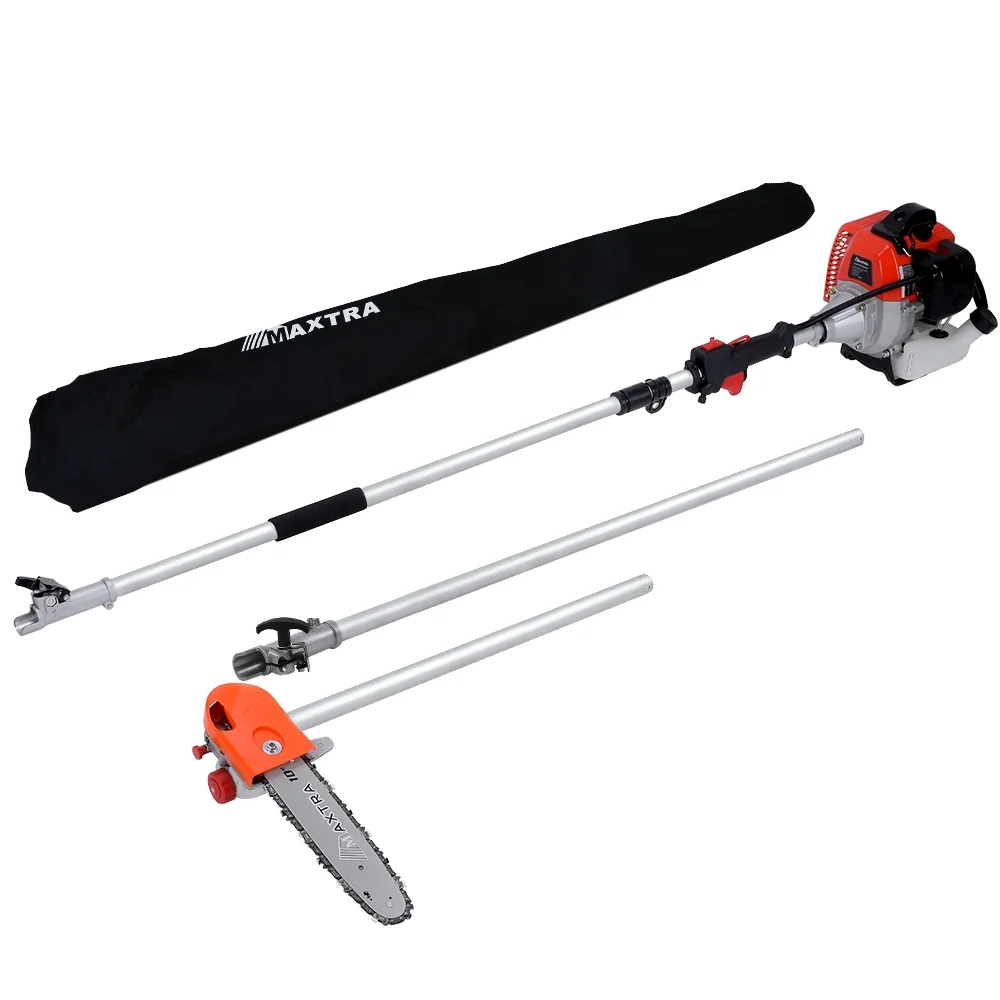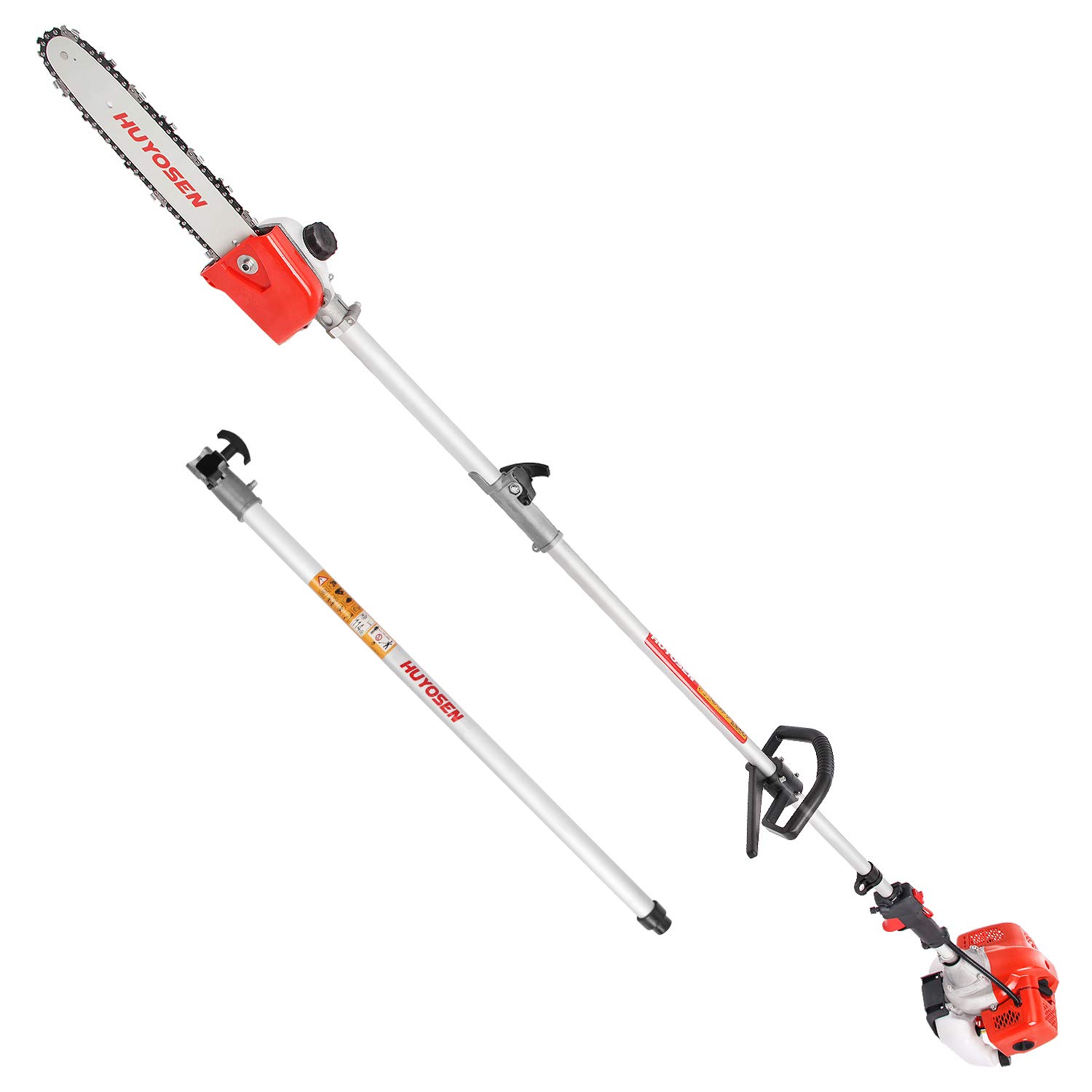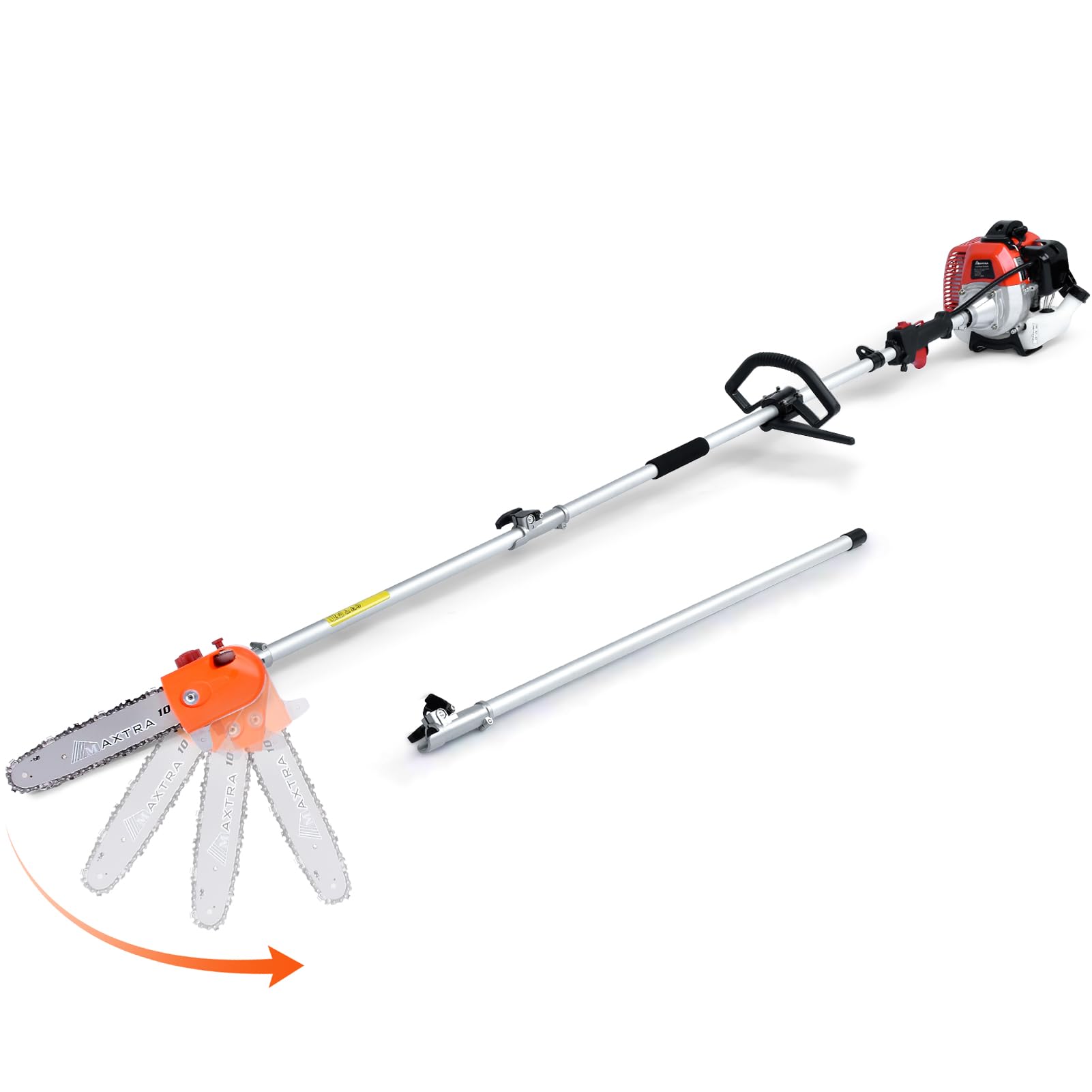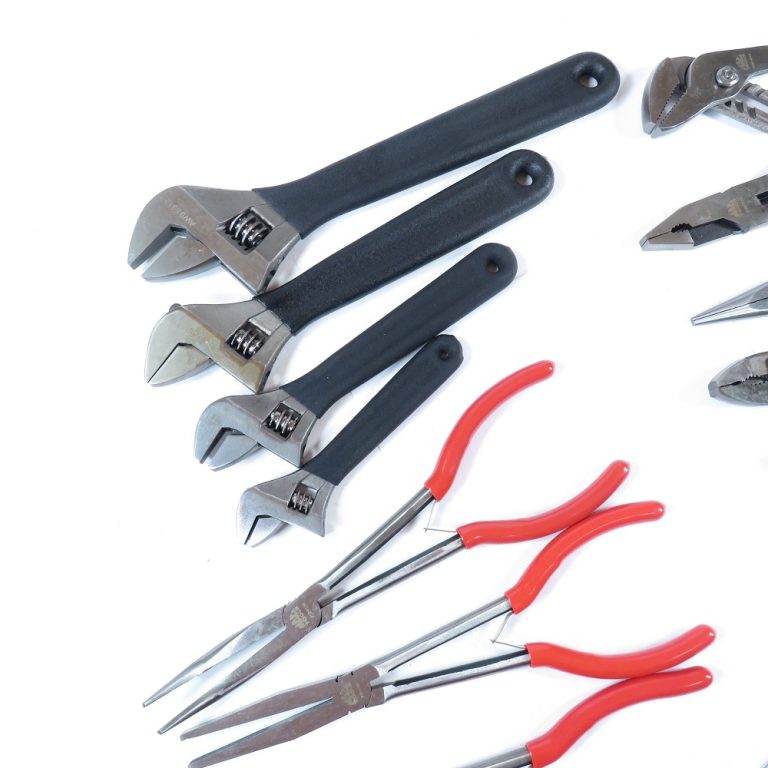Introduction to Gas Pole Saws
Gas pole saws are powerful tools for gardeners. They allow for cutting high branches with ease. With these saws, users stand on the ground and reach up to prune. This method is safer than climbing ladders with standard saws.
Gas pole saws have engines that run on fuel. This gives them more power over electric models. They do not need cords or batteries. This means users have unrestricted movement around the garden. These saws come in various lengths and engine sizes. Gardeners can choose based on the height and thickness of their trees.
These tools are also known for their durability. They can handle tough jobs and thicker branches. Gas pole saws are ideal for those with larger gardens or more demanding tasks. They offer the strength needed for cutting through hardwoods.
The freedom of movement and power makes gas pole saws a top choice. They improve productivity by cutting down time spent on pruning tasks. With proper use, they can greatly enhance garden maintenance efficiency.

Key Advantages of Using Gas Pole Saws
Gardeners reap many benefits from using gas pole saws. Here are some key advantages:
- Power and Performance: Gas pole saws pack a significant punch. They easily cut through thick branches. This makes them ideal for rigorous pruning tasks.
- Mobility: With no cords or batteries, users enjoy complete freedom. You can move around the garden without restriction. This improves your reach and efficiency.
- Versatility: These saws tackle various tree sizes and types. Adjustable lengths cater to different pruning needs. You have options for different heights and branch thicknesses.
- Durability: Built to last, gas pole saws withstand tough conditions. They handle hardwoods and repeated use with ease. This means less worry about breakdowns.
- Independence from Power Sources: Gas saws work anywhere. There’s no need for electricity. This is great for gardens far from power outlets.
- Time Savings: Gardeners cut down their pruning time with these tools. Quick starts and consistent power speed up the work.
Using gas pole saws also means less time setting up. Their design is simple and user-friendly. This lets gardeners focus on the job at hand. They can finish their tasks quicker and with less hassle.
Selecting the Right Gas Pole Saw for Your Needs
Choosing the right gas pole saw is crucial for gardening success. Before purchasing, consider a few essential factors:
- Engine Size: The engine’s power determines its cutting ability. Bigger engines handle thicker branches. Choose an engine size based on your most demanding tasks.
- Bar Length: The bar length affects your reach. Longer bars trim higher branches without a ladder. Ensure the length meets your specific height requirements.
- Weight and Balance: Use the saw comfortably for longer periods. A well-balanced and lighter saw reduces fatigue.
- Features: Look for convenient features. These can include easy start mechanisms, adjustable poles, or anti-vibration technology. They enhance comfort and ease of use.
- Brand and Warranty: Trustworthy brands offer better quality. Warranties provide security against defects and repair costs.
- Cost: Balance cost with features and quality. Invest more for a durable, high-performing saw if you often have demanding jobs.
By considering these factors, you can find the gas pole saw that fits your garden needs perfectly.

Safety Tips for Operating Gas Pole Saws
When using gas pole saws, safety cannot be overstressed. Here’s how you keep safe:
- Read the Manual: Always start by reading the manufacturer’s manual. Know your saw.
- Wear Protective Gear: Use helmets, goggles for eyes, gloves for hands, and earmuffs for hearing.
- Check the Area: Ensure no people or pets are close by. Clear away debris from your workspace.
- Inspect the Saw: Before starting, check the saw’s parts. Look for loose screws or damage.
- Fuel Carefully: Add fuel in a well-ventilated space. Wipe any spills.
- Start Safely: Place the saw on the ground to start it, not in the air.
- Use Both Hands: Always hold the gas pole saw with two hands for control.
- Balance Your Stance: Stand with feet apart for stability. Move cautiously.
- Don’t Overreach: Stay within a comfortable range. Move closer if needed.
- Turn Off When Moving: If you walk to a new spot, turn off the saw first.
- Stay Alert: Pay full attention. Don’t use the saw when tired or ill.
Following these tips when handling gas pole saws will help prevent accidents and ensure your pruning tasks are completed safely and effectively.
Maintenance and Care for Gas Pole Saws
To ensure gas pole saws stay in top condition, regular maintenance is crucial. Here are some important steps to follow:
- Clean After Use: Remove sap, dirt, and debris from the saw after each use. This prevents the build-up which can damage the saw.
- Inspect Regularly: Check the saw for loose parts or damage before each use. Tighten screws and fix issues promptly.
- Lubricate the Chain: Keep the chain well-oiled to reduce friction. This extends the life of the chain and improves cutting efficiency.
- Sharpen the Chain: A sharp chain cuts better and is safer to use. Sharpen the chain as per the manufacturer’s instructions or take it to a professional.
- Store Properly: When not in use, store your gas pole saw in a dry, safe place. Avoid exposing it to harsh weather conditions.
- Check the Fuel: Use fresh fuel and empty the tank if storing for extended periods. Stale fuel can harm the engine.
- Regular Service: Schedule professional servicing to check engine health and other critical parts.
By following these maintenance and care tips, your gas pole saw will last longer and perform better. This will help keep your garden in excellent shape year after year.

Common Applications and Techniques
Gas pole saws are not only powerful but also versatile, making them suitable for a range of gardening tasks. Whether it’s the routine trimming of small branches or the strategic shaping of larger tree limbs, gas pole saws rise to the occasion with ease and efficiency. Here are some common applications and techniques that can help you get the most out of your gas pole saw:
- Trimming and Pruning: Regularly cutting back overgrown branches helps maintain the health and appearance of trees and shrubs. Use gas pole saws to reach high branches without a ladder.
- Thinning: Removing select branches from a tree can improve light penetration and air flow, which is beneficial for the tree’s growth. This technique also prevents trees from getting too dense.
- Deadwooding: Clearing dead or diseased branches is crucial for tree health and garden safety. Gas pole saws provide the power needed to make these cuts cleanly and quickly.
- Shaping: For aesthetic purposes, shaping trees and large shrubs is often necessary. Gas pole saws offer the precision required for sculpting the garden’s greenery.
- Clearing: After storms or strong winds, fallen or precarious branches need removal. Gas pole saws can help clear away this debris efficiently.
To master these applications, use the following techniques for best results:
- Plan Your Cuts: Before starting, always plan which branches need to be cut. Look for natural joints or ‘collars’ where the branch meets the trunk as ideal spots to saw.
- Use the Right Grip: Position your hands firmly on the handles, keeping a stable grip throughout the operation.
- Smooth Operations: Begin with gentle pressure and increase as needed. Sudden movements can be dangerous and lead to uneven cuts.
- Control the Fall: When cutting larger limbs, ensure to control the fall to prevent damage to the tree or surrounding area.
- Take Breaks: Regular breaks prevent fatigue and keep you alert, improving overall safety and effectiveness.
By integrating these applications and techniques, gardeners can utilize gas pole saws to their full potential, ensuring their gardens remain well-manicured and healthy. As with any tool, practice and experience enhance both safety and efficiency, allowing for those precise cuts that perfect a garden’s landscape.
Comparing Gas Pole Saws with Electric and Battery-Operated Alternatives
When considering a pole saw for gardening, it’s important to weigh gas against electric and battery options. Here are some key comparisons:
- Power Source: Gas saws use fuel, which allows for non-stop work without the need for recharging. In contrast, electric saws require a power outlet, limiting mobility. Battery-powered saws are cordless but need periodic recharging.
- Power Output: Gas pole saws generally offer more power, which is ideal for cutting thick branches. Electric and battery saws may have less torque, which can affect their cutting abilities.
- Portability: Gas pole saws excel in areas without power sources. Electric saws limit you to areas near outlets. Battery saws offer portability, but their run time is finite.
- Weight and Handling: Gas pole saws are heavier, which can tire users over time. Electric and battery saws are typically lighter, making them easier to handle for prolonged periods.
- Maintenance: Gas saws require regular upkeep, like fuel mixing and engine servicing. Electric and battery saws need less maintenance, mainly blade sharpening and battery care.
- Noise Level: Gas saws are louder, which may be an issue in noise-sensitive areas. Electric and battery options are quieter, making them more neighbor-friendly.
- Environmental Impact: Electric and battery saws are more eco-friendly, eliminating emissions. Gas saws emit fumes, which have a greater environmental footprint.
- Cost: Initial outlay for gas saws is often higher, and they have ongoing fuel costs. Electric and battery saws may have lower starting prices and no fuel costs, but battery replacement can be expensive.
Choosing the right type of pole saw hinges on your specific needs. Consider your garden’s size, branch thickness, budget, and how often you’ll use the saw. Gas pole saws suit larger, more demanding jobs, while electric and battery saws are ideal for smaller tasks and quieter operations.

Future of Gas Pole Saws in Gardening
The future of gas pole saws in gardening looks promising. As technology advances, so do the features of these powerful tools. Here are some potential future developments for gas pole saws:
- Eco-Friendly Innovations: Efforts to reduce emissions will lead to cleaner models. These eco-friendly saws will meet environmental standards while maintaining power.
- Enhanced Ergonomics: Designs will focus more on user comfort. Expect lighter, more balanced models that reduce fatigue during use.
- Improved Fuel Efficiency: Future gas pole saw might use fuel more efficiently. This will decrease running costs and increase appeal to cost-conscious gardeners.
- Integration of Digital Technology: We might see smart features in gas pole saws. For example, devices that track usage, maintenance reminders, or even GPS for large gardens.
- Versatility and Attachments: Future models could offer interchangeable heads. This would turn a saw into a hedge trimmer, pruner, or other tools quickly.
These advancements will make gas pole saw even more essential for gardeners. They will offer greater convenience, efficiency, and eco-friendliness. As these improvements unfold, gas pole saw will continue to be a top choice for serious garden tasks.







